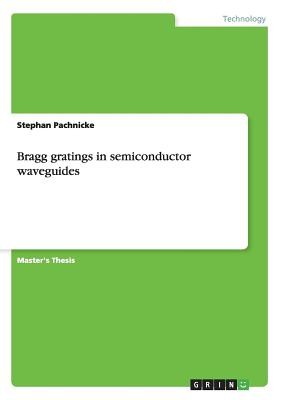
- We will send in 10–14 business days.
- Author: Stephan Pachnicke
- Publisher: GRIN Verlag
- Year: 2007
- Pages: 108
- ISBN-10: 3638708780
- ISBN-13: 9783638708784
- Format: 14.8 x 21 x 0.7 cm, softcover
- Language: English
- SAVE -10% with code: EXTRA
Reviews
Description
Master's Thesis from the year 2001 in the subject Electrotechnology, grade: with distinction, City University London, language: English, abstract: Bragg gratings are important devices for both optical communications and sensing. These devices are used to design very narrow band optical filters, which can be used in wavelength division multiplexing (WDM). It is also perceived that Bragg gratings will be used to compensate the dispersion in modern fibre optic telecommunication networks. Semiconductor gratings are usually integrated into lasers to control the operating wavelength. City University Photonic Modelling Group is a world leading research group on the use of rigorous numerical techniques to design and optimise advanced photonic devices for optical communications. The research group has already achieved results on hypothetical one-dimensional (1-D) and realistic two-dimensional (2-D) structures. In this project a combination of three numerical methods has been used, all of which are rigorous, to simulate realistic three-dimensional (3-D) structures in semiconductor waveguides. The combination of these three accurate methods, the finite element method (FEM), the least squares boundary residual (LSBR) method and the transfer matrix method (TMM) turned out to be superior to the widely used coupled mode theory (CMT). The numerical study of different Bragg gratings shows interesting dependencies of the characteristics of the gratings on the different design parameters. The work was carried out for different mesh distributions, different numbers of mesh divisions and different computational parameters. Another focus of the work was on the stability of the transmission and reflection coefficients obtained from the LSBR program. Furthermore the effect of inaccuracy occurring during the fabrication process has been studied. The results of this work have been compared to results found by other groups and fellows. We can say that this project is quite new in the field of
EXTRA 10 % discount with code: EXTRA
The promotion ends in 17d.01:04:22
The discount code is valid when purchasing from 10 €. Discounts do not stack.
- Author: Stephan Pachnicke
- Publisher: GRIN Verlag
- Year: 2007
- Pages: 108
- ISBN-10: 3638708780
- ISBN-13: 9783638708784
- Format: 14.8 x 21 x 0.7 cm, softcover
- Language: English English
Master's Thesis from the year 2001 in the subject Electrotechnology, grade: with distinction, City University London, language: English, abstract: Bragg gratings are important devices for both optical communications and sensing. These devices are used to design very narrow band optical filters, which can be used in wavelength division multiplexing (WDM). It is also perceived that Bragg gratings will be used to compensate the dispersion in modern fibre optic telecommunication networks. Semiconductor gratings are usually integrated into lasers to control the operating wavelength. City University Photonic Modelling Group is a world leading research group on the use of rigorous numerical techniques to design and optimise advanced photonic devices for optical communications. The research group has already achieved results on hypothetical one-dimensional (1-D) and realistic two-dimensional (2-D) structures. In this project a combination of three numerical methods has been used, all of which are rigorous, to simulate realistic three-dimensional (3-D) structures in semiconductor waveguides. The combination of these three accurate methods, the finite element method (FEM), the least squares boundary residual (LSBR) method and the transfer matrix method (TMM) turned out to be superior to the widely used coupled mode theory (CMT). The numerical study of different Bragg gratings shows interesting dependencies of the characteristics of the gratings on the different design parameters. The work was carried out for different mesh distributions, different numbers of mesh divisions and different computational parameters. Another focus of the work was on the stability of the transmission and reflection coefficients obtained from the LSBR program. Furthermore the effect of inaccuracy occurring during the fabrication process has been studied. The results of this work have been compared to results found by other groups and fellows. We can say that this project is quite new in the field of


Reviews